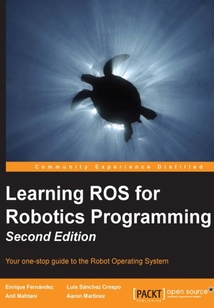首頁 > 計(jì)算機(jī)網(wǎng)絡(luò) >
編程語言與程序設(shè)計(jì)
> Learning ROS for Robotics Programming(Second Edition)最新章節(jié)目錄
舉報(bào) 

會員
Learning ROS for Robotics Programming(Second Edition)
最新章節(jié):
Index
Ifyouhaveevertriedbuildingarobot,thenyouknowhowcumbersomeprogrammingeverythingfromscratchcanbe.ThisiswhereROScomesintothepicture.Itisacollectionoftools,libraries,andconventionsthatsimplifiestherobotbuildingprocess.What’smore,ROSencouragescollaborativeroboticssoftwaredevelopment,allowingyoutoconnectwithexpertsinvariousfieldstocollaborateandbuilduponeachother'swork.Packedfullofexamples,thisbookwillhelpyouunderstandtheROSframeworktohelpyoubuildyourownrobotapplicationsinasimulatedenvironmentandshareyourknowledgewiththelargecommunitysupportingROS.Startingatanintroductorylevel,thisbookisacomprehensiveguidetothefascinatingworldofrobotics,coveringsensorintegration,modeling,simulation,computervision,navigationalgorithms,andmore.Youwillthengoontoexploreconceptsliketopics,messages,andnodes.Next,youwilllearnhowtomakeyourrobotseewithHDcameras,ornavigateobstacleswithrangesensors.Furthermore,thankstothecontributionsofthevastROScommunity,yourrobotwillbeabletonavigateautonomously,andevenrecognizeandinteractwithyouinamatterofminutes.What’snewinthisupdatededition?Firstandforemost,wearegoingtoworkwithROSHydrothistimearound.Youwilllearnhowtocreate,visualize,andprocessPointCloudinformationfromdifferentsensors.ThiseditionwillalsoshowyouhowtocontrolandplanmotionofroboticarmswithmultiplejointsusingMoveIt!Bytheendofthisbook,youwillhaveallthebackgroundyouneedtobuildyourownrobotandgetstartedwithROS.
目錄(108章)
倒序
- coverpage
- Learning ROS for Robotics Programming Second Edition
- Credits
- About the Author
- Acknowledgments
- About the Author
- Acknowledgments
- About the Author
- Acknowledgments
- About the Author
- Acknowledgments
- About the Reviewer
- About the Reviewer
- Acknowledgments
- About the Reviewers
- www.PacktPub.com
- Support files eBooks discount offers and more
- Preface
- What this book covers
- What you need for this book
- Who this book is for
- Conventions
- Reader feedback
- Customer support
- Chapter 1. Getting Started with ROS Hydro
- PC installation
- Installing ROS Hydro – using repositories
- How to install VirtualBox and Ubuntu
- Installing ROS Hydro in BeagleBone Black (BBB)
- Summary
- Chapter 2. ROS Architecture and Concepts
- Understanding the ROS Filesystem level
- Understanding the ROS Computation Graph level
- Understanding the ROS Community level
- Tutorials to practice with ROS
- Summary
- Chapter 3. Visualization and Debug Tools
- Debugging ROS nodes
- Logging messages
- Inspecting what is going on
- Setting dynamic parameters
- When something weird happens
- Visualizing node diagnostics
- Plotting scalar data
- Image visualization
- 3D visualization
- Saving and playing back data
- Using the rqt_gui and rqt plugins
- Summary
- Chapter 4. Using Sensors and Actuators with ROS
- Using a joystick or a gamepad
- Using a laser rangefinder – Hokuyo URG-04lx
- Using the Kinect sensor to view objects in 3D
- Using servomotors – Dynamixel
- Using Arduino to add more sensors and actuators
- Using an ultrasound range sensor with Arduino
- How distance sensors send messages
- Using a low-cost IMU – 10 degrees of freedom
- Using a GPS system
- Summary
- Chapter 5. Computer Vision
- Connecting and running the camera
- Writing your own USB camera driver with OpenCV
- Calibrating the camera
- The ROS image pipeline
- ROS packages useful for Computer Vision tasks
- Using visual odometry with viso2
- Performing visual odometry with an RGBD camera
- Computing the homography of two images
- Summary
- Chapter 6. Point Clouds
- Understanding the point cloud library
- My first PCL program
- Segmentation
- Summary
- Chapter 7. 3D Modeling and Simulation
- A 3D model of our robot in ROS
- Creating our first URDF file
- Xacro – a better way to write our robot models
- Simulation in ROS
- Summary
- Chapter 8. The Navigation Stack – Robot Setups
- The navigation stack in ROS
- Creating transforms
- Publishing sensor information
- Publishing odometry information
- Creating a base controller
- Creating a map with ROS
- Summary
- Chapter 9. The Navigation Stack – Beyond Setups
- Creating a package
- Creating a robot configuration
- Configuring the costmaps – global_costmap and local_costmap
- Creating a launch file for the navigation stack
- Setting up rviz for the navigation stack
- Adaptive Monte Carlo Localization
- Modifying parameters with rqt_reconfigure
- Avoiding obstacles
- Sending goals
- Summary
- Chapter 10. Manipulation with MoveIt!
- The MoveIt! architecture
- Integrating an arm in MoveIt!
- Simple motion planning
- Motion planning with collisions
- The pick and place task
- Summary
- Index 更新時間:2021-07-16 20:46:08
推薦閱讀
- 從零開始:數(shù)字圖像處理的編程基礎(chǔ)與應(yīng)用
- Oracle 11g從入門到精通(第2版) (軟件開發(fā)視頻大講堂)
- AWS Serverless架構(gòu):使用AWS從傳統(tǒng)部署方式向Serverless架構(gòu)遷移
- React Native Cookbook
- 基于Java技術(shù)的Web應(yīng)用開發(fā)
- Selenium Design Patterns and Best Practices
- C語言程序設(shè)計(jì)
- Processing互動編程藝術(shù)
- Mastering Scientific Computing with R
- Learning Firefox OS Application Development
- Learning Nessus for Penetration Testing
- Instant Zurb Foundation 4
- Oracle Database XE 11gR2 Jump Start Guide
- Distributed Computing with Python
- JavaScript編程精解(原書第3版)
- Learn C Programming
- Splunk Developer's Guide(Second Edition)
- Learning Android Application Development
- Unreal Engine 4 Scripting with C++ Cookbook
- Metasploit for Beginners
- C語言從入門到精通(第6版)
- 深入理解Java虛擬機(jī):JVM高級特性與最佳實(shí)踐(第3版)
- INSTANT Apache Solr for Indexing Data How-to
- PHP程序員面試筆試真題與解析
- OpenLayers 3.x Cookbook(Second Edition)
- 系統(tǒng)辨識理論及Matlab仿真
- Learning SAP BusinessObjects Dashboards
- Kali Linux 2:Assuring Security by Penetration Testing(Third Edition)
- Java從入門到精通(第6版)
- PowerCLI Essentials

